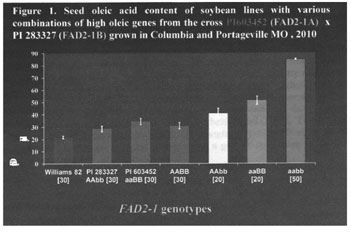High Oleic Acid Soybeans For Wider Use Of Oil In Food, Fuel And Other Products
PORTAGEVILLE, MO.
In 2009, soybean [Glycine max (L.) Merr] represented 53% of the world’s vegetable oil seed production and is the world’s dominant vegetable oil. Soybean oil was second in world edible oil consumption and biodiesel utilization (www.soystats.com). Although soybean oil is widely used, it has limitations preventing use in many products versus other vegetable oils. Five fatty acids make up the oil portion of soybean seed. Soybean oil averages 12% palmitic acid, 4% stearic acid, 23% oleic acid, 53% linoleic acid and 8% linolenic acid. The palmitic and stearic fractions are saturated fatty acids and constitute 15% of the soybean oil. The remainder (about 85%) is made up of unsaturated fatty acids. Because of demand for healthier, more functional vegetable oils, greater emphasis has been placed on modifying the fatty acid profile in soybean seed. Soybean fatty acid profiles are being targeted that have the highest probability to expand use of oil in edible, fuel and industrial applications. Soybean oil research priorities were set, with guidance from consumers and endusers. The most visible of these programs was “The Better Bean Initiative” launched by the United Soybean Board (USB). This program’s aim is to add value to the oil components by genetically changing objectionable characteristics. Several USA universities have been funded by USB with a goal of developing of soybeans with high oleic, low linolenic and low saturated seed oil.
The primary limitation of soybean oil is low oxidative stability which reduces shelf life, flavor and durability at high temperatures; and poor cold flow properties for biodiesel. To improve oxidative stability and undesirable taste, soy oil is hydrogenated to reduce double bonds which are sites of oxidative attack that reduce stability, shelf life and increase off-flavor. Partial hydrogenation of soybean oil increases oxidative stability, but forms trans-fats which are undesirable because consuming them is associated with increased heart disease in humans.

A goal of the USB oil improvement program is to increase seed oleic acid content from 23% to greater than 60%. Oleic acid is a monounsaturated fatty acid which facilitates improved health and oxidative stability for increased oil shelf life, flavor, durability and cold flow performance. Increasing oleic acid to more than 60% will improve edible and industrial applications. High oleic soy oil reduces the need for hydrogenation and eliminates trans-fats and would improve soy-diesel, lubricants and hydraulic oils. A diet in which fat consumption is high in oleic acid, like olive oil, is associated with reduced cholesterol, arteriosclerosis and heart disease. High oleic acid also extends the utility of soybean oil at high cooking temperatures and also increases soybean oil functionality in pharmaceuticals and cosmetics.
Breeders have aimed at developing soybeans with higher oleic acid content for more than 30 years. About 10 years ago, soybean breeding lines with oleic acid content of up to 60% were developed. However, inheritance of the high oleic levels in these soybeans required six genes. Because of this complex inheritance breeders were unsuccessful in developing higher oleic cultivars with productivity comparable to current soybean varieties. At the University of Missouri we identified and evaluated plant introductions (PIs) in the USDA soybean germplasm collection with elevated oleic acid concentration of about 30% to 45% hoping control of the oleic trait would involve only one or two genes to simplify introducing the trait into high yielding varieties. Two lines each with higher than average (30-40%) oleic acid content were crossed and progeny were identified with >70% oleic acid concentration in soybean seed oil. Genetic studies indicated two recessive genes (Fad2-1A and Fad2-1B) were responsible for the higher oleic acid concentration in each of the higher oleic parents. When the two genes were combined as homozygous recessive (aabb) from crossing each line having a different Fad2-1 gene, the high oleic trait was expressed. Figure 1 is a histogram showing the distribution of oleic acid among progeny and parents from a cross of lines with different combinations of the high oleic Fad2-1A and Fad2-1b genes.
The new oil is similar to the high oleic soybean “Plenish” from DuPont and “Vistive” from Monsanto. The difference in the University of Missouri- USB supported high oleic soybean versus Plenish and Vistive is that the new soybeans were developed by combining two genes that occur naturally through traditional breeding techniques. The Monsanto and DuPont products were developed by transgenic or biotechnology approaches and requires a lengthy process to get their traits through required regulatory approval to allow production. Because the USB-University of Missouri research involves no genetically modified (non-GMO) breeding processes, regulatory approval is not required. Soybean breeders are incorporating the non-GMO high oleic trait into soybean varieties of all maturity groups that can be grown in all parts of the United States. However, Monsanto and DuPont may only incorporate their Vistive and Plenish high oleic traits into soybeans with a limited area of adaptation such as Central Iowa or Northern Illinois limiting availability of the high oleic beans to all US farmers.
The new non-GMO high oleic beans are being compared to beans with normal oil to determine if there the trait has any affect on yield and other agronomic traits. The high oleic content from some sources is decreased under lower temperatures. The new trait is being tested in the northern USA to insure that the high oleic content remains acceptable under cooler temperatures. The new non-GMO genes appear to be less influenced by temperature than previous higher oleic sources and the oleic content should be comparable to Plenish and Vistive which are stable when grown across various environments. Δ
DR. GROVER SHANNON: Professor, David Haggard Endowed Chair, Soybean Genetics and Breeding University of Missouri